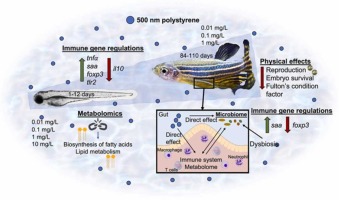15 November 2021
Zebrafish reproduction affected by plastic particles in the aquatic environment
Reproduction
Cross disciplinary studies on plastic nanoparticles and their effects on the reproduction in zebrafish:The Journal of Hazardous Materials.

Plastic nanoparticles cause mild inflammation, disrupt metabolic pathways, change the gut microbiota and affect reproduction in zebrafish: A full generation multi-omics study
by Moonika Haahr Marana, Rikke Poulsen, Eiríkur Andri Thormar, Cecilie Grønlund Clausen, Amalie Thit, Heidi Mathiessen, Rzgar Jaafar, Rozalia Korbut, Anna Magdalene Brun Hansen, Martin Hansen, Morten Tønsberg Limborg, Kristian Syberg, Louise von Gersdorff Jørgensen
Abstract
Plastic pollution has become a major concern on a global scale. The plastic is broken down into minuscule particles, which have an impact on the biosystems, however long-term impacts through an entire generation is largely unknown. Here, we present the first whole generation study exposing fish to a 500 nm polystyrene plastic particle at environmentally relevant concentrations. Short- and long-term adverse effects were investigated in the zebrafish model organism using a holistic multi-omics approach. The particles accumulated in the yolk sac of young larvae and short-term biological impacts included immune-relevant gene regulation related to inflammation and tolerance as well as disruption of metabolic processes, such as the fatty acid and lipid pathways. The long-term effects comprised gene regulations pointing towards skin and/or gill inflammation, dysbiosis of the gut microbiota, a decreased condition factor in adult males as well as a lowered reproductive capability. From this study, it can be concluded that exposure to nanoplastic particles have an impact on population as well as ecosystem level in fish and likely also in other vertebrates.
See til full article: https://doi.org/10.1016/j.jhazmat.2021.127705
Topics

